|
The

is now in Color
(When you click on a picture to enlarge it you can move it around by clicking on the grey bar along the top. To close it click on "CLOSE" at the upper right corner of the picture)
|
|
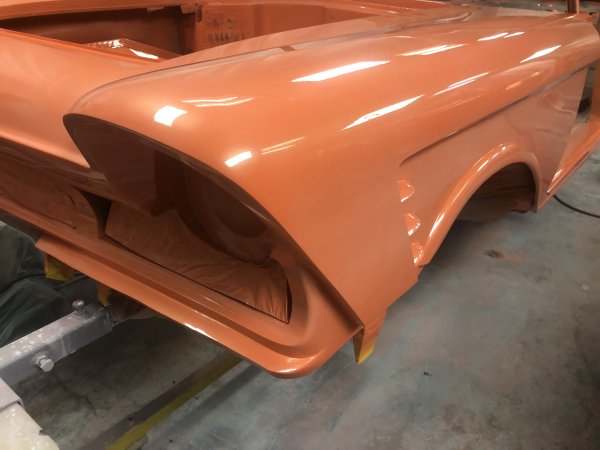 Finally!!
Finally!!
|
The paint color is wonderful
...but before we get to that I'll show you everything that took place before the paint.
Rebuilding the transmission
I left off last time with the body in epoxy primer after sandblasting
and sanding to prevent flash rust.
I decided to get my hands pretty dirty one day in late September
so I set up a makeshift table in the shop and brought in the transmission
for the car and began to disassemble it to rebuild it.
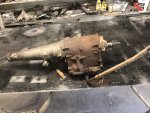 It looked like the many other Ford-O-Matic transmissions I’ve rebuilt over the years until I took the pan off.
Incidentally, this is a Merc-O-Matic transmission which is exactly the same as a Ford-O-Matic except for the name.
They are three speed trannys with only two forward speeds shown on the shift indicator.
They show “L” for low and “D” for drive.
When in Drive it actually takes off in second gear and shifts to third at speed.
The only time you get low gear is when you manually shift to “L”.
Sitting all those years turned the transmission fluid to mud and left a lot of sludge in the pan.
It looked like the many other Ford-O-Matic transmissions I’ve rebuilt over the years until I took the pan off.
Incidentally, this is a Merc-O-Matic transmission which is exactly the same as a Ford-O-Matic except for the name.
They are three speed trannys with only two forward speeds shown on the shift indicator.
They show “L” for low and “D” for drive.
When in Drive it actually takes off in second gear and shifts to third at speed.
The only time you get low gear is when you manually shift to “L”.
Sitting all those years turned the transmission fluid to mud and left a lot of sludge in the pan.
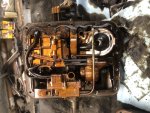
This photo is with the pan and filter removed.
I purchased a complete rebuild kit with new clutches and steels
as well as the bands and a filter from FATSCO.com.
They are a great source for old Ford Transmission parts.
There are step by step instructions in the shop manual which are very easy to follow
for complete disassembly of all the sub-assemblies and reassembly.
Every assembly was completely disassembled and thoroughly cleaned.
All new seals and gaskets were installed.
The empty case was glass bead blasted on the outside
before thoroughly cleaning inside and outside and then a coat of cast iron paint was applied to the outside.
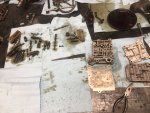 This is the valve body completely disassembled;
it’s the most complex assembly in the transmission.
And here is a shot with everything cleaned and back where it belongs
This is the valve body completely disassembled;
it’s the most complex assembly in the transmission.
And here is a shot with everything cleaned and back where it belongs
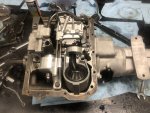
The torque converter was also disassembled, cleaned, re-sealed and reassembled.
It’s an air cooled torque converter with fins on it and the bell housing has vents
in it to circulate the air for cooling the transmission.
There are no cooling lines between the transmission and radiator like later cars have.
Sometime in October I got the engine back from Midwest Engine Rebuilders in Duluth.
I painted it and installed the new valve covers, exhaust manifolds and a few other parts.
You’ll recall from an earlier update how the valve covers were made.
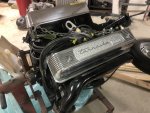
You may also recall from an earlier update that sometime in the cars early past
someone stole the dual quad intake manifold, carburetors, choke housing and valve covers from the XMTC.
Those too were one-off parts that were specially built to fit under the hood of the XMTC.
Fabricating the new choke housing
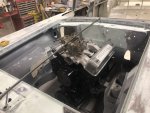
I tried to fit a standard 1956 2X4 intake and carbs under the hood,
but I would have had to put a hood scoop on the car.
I checked with Holley and Edelbrock to see if they had carburetors
that may be short enough to fit under the hood
but they would require ½” thick adapter plates to fit the intake manifold
so that would leave the tops of the air horns level with the underside of the hood,
leaving no space to get air into the carburetors.
So after some thought I decided to install a single 4bbl carburetor on the engine.
Hopefully the guy who stole the original parts will read this update
and maybe get religion and return the parts to me, but that’s probably not likely.
So until that happens I’ll have to live with
the single 4bbl intake and 56 Mercury Carter Carburetor on the car.
I fabricated a new choke housing to fit the Carter
and it’s at AIH Chrome Plating in Dubuque Iowa right now getting plated.
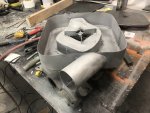
This is the inside of the choke housing fitted around the carburetor air horn and secondary diaphragm.
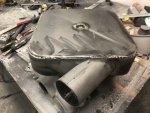
There will be a choke flap in the hole on the snout connected to a cable and to a knob on the dash.
The dash gauges need refreshing too...
While I was sidetracking from preparing the body for paint I also rebuilt the dash gauges.
The original paint on the back of the faces was cracked and peeling.
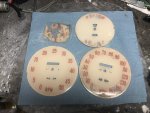
Fortunately the numbers and dashes on the faces were engraved in the back side.
I was able to first sand all of the off white paint off down to the plastic,
and then the orange paint in the engraved numbers
was easily picked out of the grooves with a dental pick.
I hand painted new orange paint back in and then sprayed a matching off white
over the backs and they came out beautiful,
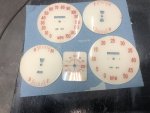 The gauges have a jeweled (aka engine turning) aluminum trim over the center of them.
The jeweling had been somehow faded away so I went to work re-jeweling them.
Years ago when I restored the 1963 Thunderbird Italien Concept car
I learned how to do the jeweling as that car had a lot of it on the dash,
door panels and exterior trim so these couple small pieces were a breeze.
The gauges have a jeweled (aka engine turning) aluminum trim over the center of them.
The jeweling had been somehow faded away so I went to work re-jeweling them.
Years ago when I restored the 1963 Thunderbird Italien Concept car
I learned how to do the jeweling as that car had a lot of it on the dash,
door panels and exterior trim so these couple small pieces were a breeze.
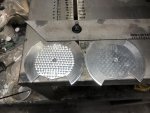
In this photo the piece on the left is freshly jeweled.
Notice how much sharper it is than the piece on the right.
Here is the speedometer completed. Notice that I reset the odometer to all “0’s”
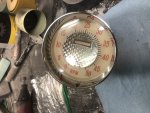 I was able to find NOS gauges for the fuel, temp, oil and amps on Ebay
so all gauges will be fresh.
I even replaced the tick-tock mechanism in the clock that no longer worked with a modern quartz movement.
I was able to find NOS gauges for the fuel, temp, oil and amps on Ebay
so all gauges will be fresh.
I even replaced the tick-tock mechanism in the clock that no longer worked with a modern quartz movement.
New dash knobs too
I think I mentioned in one of my earlier updates that my son-in-law
has one of those 3D printers,
anyway I sent him the three different dash knobs I needed and voila!
He made perfect copies.
They will all be painted pearl white and the two largest
will have lights inside which are the turn signal indicators
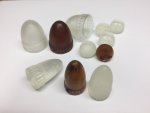
Fortunately I had one good one of each for him to copy.
Power windows will raise again
Next I moved on to the power window mechanisms,
since one of them had a couple broken teeth on one of the gears I began with that one.
I removed the gear from the assembly,
filed a square notch where the broken gear was,
and drilled a 1/8” hole in the center of the notch.
Next I took a grade 8 bolt and machined ½” of it down
to fit tightly in the 1/8” hole I drilled.
Then I ground the top of it the approximate dimensions of the missing tooth.
I applied a dab of JB Weld on the peg and drove the new tooth into the hole.
Finally I used the Dremel tool to refine the shape.
I had to do this for two of the teeth.
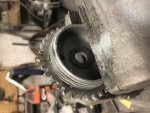
Then I assembled the window mechanisms with new motors.
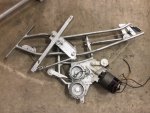
Almost all of the components for the car are rebuilt/refinished now so it’s time to get the main parts ready.
Getting back to the body
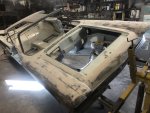
Here’s what it looked like just before the two coats of high build primer went on.
There was also a guide coat of a very watered down dark colors
sprayed over the primer which again is sanded with 180 grit sandpaper on long boards.
The idea is to sand enough to get all the guide coat off and leave a clear gray finish.
Any depressions will show as dark spots
as you can see in the circle of this picture of the partially sanded roof:
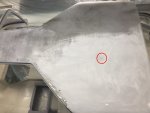
That area went away with a little more sanding.
Had it not, I would have spread a small amount of filler on it and re sanded it.
The next step was to spray another 2 coats of sealer
over everything and wet sand it with a small block and 400-600 grit sandpaper
after which with a good cleaning it’s ready for paint.
And here are a couple pictures in living color:
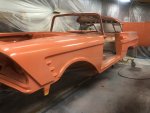 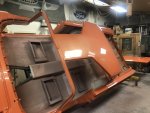 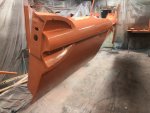 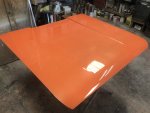
There’s still a lot of work to do to the finish before calling it done.
When you paint in a shop such as mine its unavoidable to get some dust in the finish.
The good news is with today’s paint products
and a little elbow grease they can be cleaned up.
It’s called color sanding and buffing.
I’ll do 3-4 sandings on the paint starting with 800 grit,
then 1000 followed by 1500 and finally 2000 grit sanding’s.
After the sanding’s 2-3 buffing’s are required
with different grit buffing compounds
so I still have a lot of work to do before I begin reassembly of the car.
After I finished the color sanding Ialways like to install the name script on the car.
Here is the front fender script and the nose panel script.
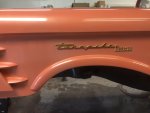 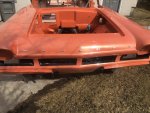
Next I began installing the front and rear suspension parts
so I could get the car back on it's wheels and off the rotisserie.
Here are the front and rear brake assemblies back together,
but first is the way it used to look:
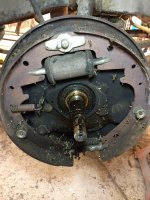 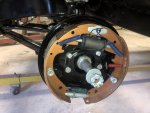 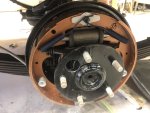
And last but not least for this update is the 1956 XM Turnpike Cruiser rolling again!
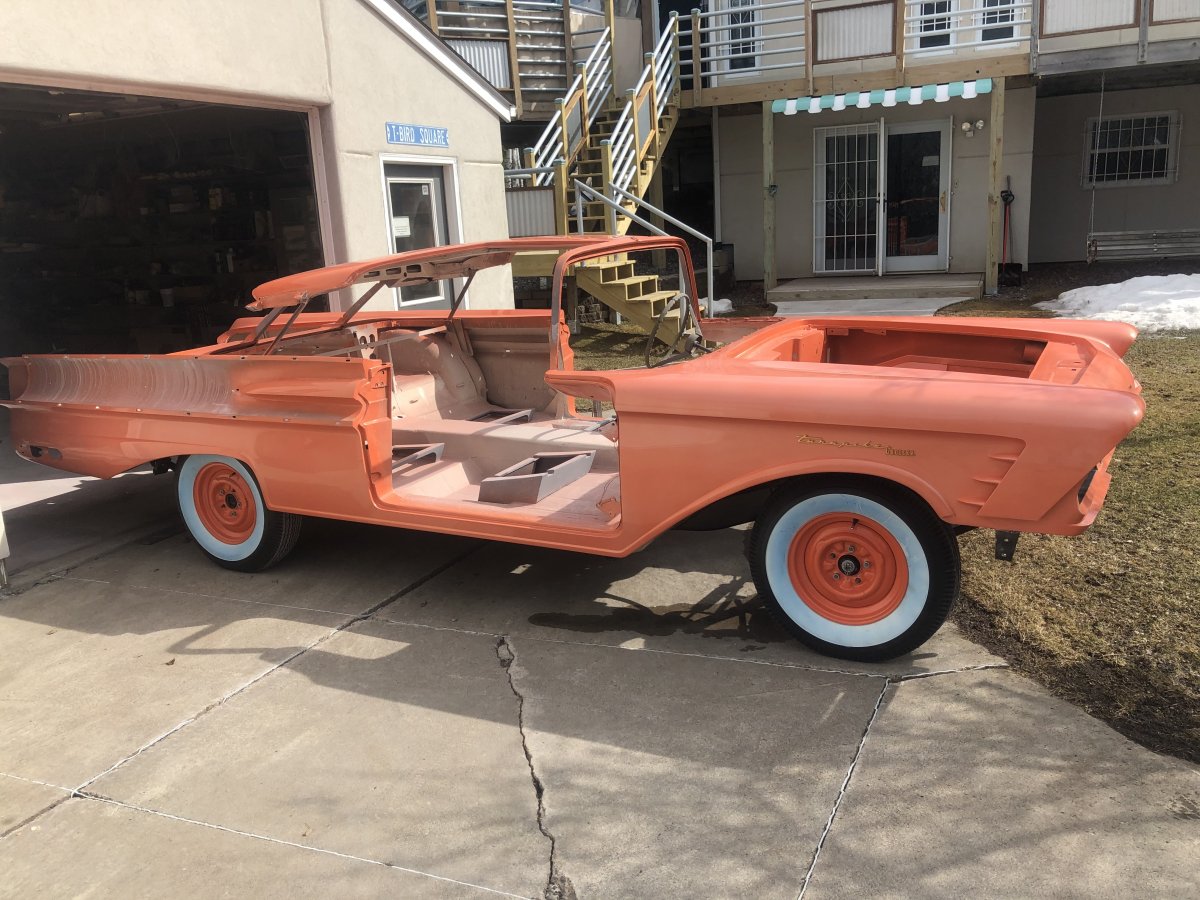
|
|

